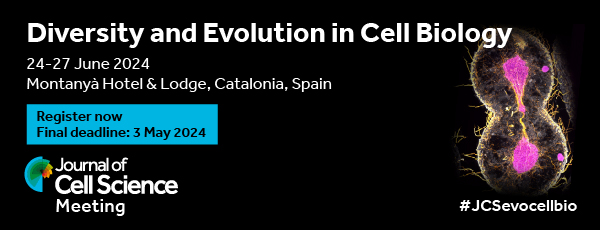Issues
-
Cover image
Cover Image

Cover: Confocal image representing GW182 localization in rat cerebellum. The pseudocoloured image depicts the merge of calbindin (a Purkinje marker; red) and GW182 (green) staining in a P15 rat cerebellum section. The image shows that GW182 is present in both the cell bodies and dendrites of cerebellar granule and Purkinje neurons at P15. Strikingly, the dendritic expression of GW182 significantly reduces in P30 cerebellum. Our work shows that the dendritic expression of GW182 during the critical neurodevelopmental window plays an important role in regulating dendritic growth and arborization. See article by B. Nawalpuriet al. (jcs258465).
- PDF Icon PDF LinkTable of contents
- PDF Icon PDF LinkIssue info
RESEARCH HIGHLIGHTS
STICKY WICKET
FIRST PERSON
CELL SCIENTISTS TO WATCH
REVIEWS
Electrically tunable lenses – eliminating mechanical axial movements during high-speed 3D live imaging
Summary: Electrically tunable liquid lenses possess shape-changing principles. We discuss their recent applications, limitations and emerging solutions in enabling high-speed cost-effective 3D live microscopy.
The structure and function of centriolar rootlets
Summary: This Review discusses the structure and function of enigmatic cytoskeletal fibres termed centriolar rootlets, suggesting that they form physical links between subcellular structures to allow collective organelle function.
SHORT REPORT
Phosphorylation in the intrinsically disordered region of F-BAR protein Imp2 regulates its contractile ring recruitment
Summary: Phosphorylation of the F-BAR protein Imp2 within its intrinsically disordered region modulates its localization and function at the contractile ring.
RESEARCH ARTICLES
LFA-1 and kindlin-3 enable the collaborative transport of SLP-76 microclusters by myosin and dynein motors
Summary: LFA-1 and kindlin-3 play unconventional roles in the dynein-dependent and talin-1-independent centripetal transport of actomyosin-associated SLP-76 microclusters and in TCR-proximal signaling pathways.
Distinct temporal expression of the GW182 paralog TNRC6A in neurons regulates dendritic arborization
Summary: Developmentally regulated expression of the miRISC protein GW182 plays an important role in determining dendritic arborization by regulating somatodendritic translation and actin cytoskeletal dynamics.
Loss of kinesin-8 improves the robustness of the self-assembled spindle in Schizosaccharomyces pombe
Summary: We report a comparative analysis of self-assembled spindles and canonical centrosomal spindles in fission yeast, which could clarify the mechanisms underlying acentrosomal meiosis.
A three-dimensional spheroid-specific role for Wnt–β-catenin and Eph–ephrin signaling in nasopharyngeal carcinoma cells
Summary: We report a new 3D spheroid model of Epstein–Barr virus-positive and -negative nasopharyngeal carcinoma that resembles advanced and metastatic tumors and has potential use in drug target identification.
The Bardet–Biedl syndrome complex component BBS1 controls T cell polarity during immune synapse assembly
Highlighted Article: The Bardet–Biedl syndrome complex component BBS1 regulates proteasome-dependent F-actin clearance from the centrosome to enable its translocation to the T cell immune synapse.
A polycystin-2 protein with modified channel properties leads to an increased diameter of renal tubules and to renal cysts
Summary: Replacement of the pore region of polycystin-2 with that of polycystin-2L1 results in wider renal tubules and polycystic kidney disease, thus demonstrating the essential function of its ion channel properties.
A developmental stage- and Kidins220-dependent switch in astrocyte responsiveness to brain-derived neurotrophic factor
Summary: Here, we describe how astrocytes respond differently to stimuli of growth factor during development and the postnatal stage, and the role of the Kidins220 protein in this process.
The role of Aspergillus nidulans polo-like kinase PlkA in microtubule-organizing center control
Summary: Eukaryotic cells need large protein complexes to produce microtubules. We studied the regulation of nuclear and septum-associated microtubule-organizing complexes, and their coordination in one cell.
EVI/WLS function is regulated by ubiquitylation and is linked to ER-associated degradation by ERLIN2
Highlighted Article: The WNT secretory factor EVI/WLS is ubiquitylated and linked to ER-associated degradation by multiple proteins, providing insight into the link between WNT signalling and the ubiquitin–proteasome system.
Mechanical and chemical activation of GPR68 probed with a genetically encoded fluorescent reporter
Highlighted Article: We report a genetically encoded fluorescent reporter sensitive to all known activators of GPR68, a G-protein-coupled receptor involved in many important physiological functions.
An SR protein is essential for activating DNA repair in malaria parasites
Summary: There is an unexpected role for the alternative splicing factor PfSR1 in activating the DNA damage response in the human malaria parasite Plasmodium falciparum.
Introducing our new Editors

We welcome three new Editors to Journal of Cell Science - Robert Parton, Richa Rikhy and Simon Cook. You can read more about them in the Editorial from our Editor-in-Chief Michael Way.
2024 Journal Meeting 'Diversity and Evolution in Cell Biology'

Registration is open for our 2024 Journal Meeting Diversity and Evolution in Cell Biology, which aims to bring together evolutionary biologists and cell biologists investigating diverse aspects of cellular physiology. Final registration deadline: 3 May 2024.
Workshop: Physics of the Early Embryonic Cell Divisions

Early-career researchers interested in the roles of nuclear lipids, apply now for one of the ten funded places at this Workshop, which will take place 11-14 November 2024. Application deadline: 17 May.
Reasons to submit to Journal of Cell Science

There are many benefits to publishing in Journal of Cell Science - read more about why you should choose JCS or visit our submission page now.
Propose a new Workshop for 2026

We are now accepting proposals for our 2026 Workshops programme. We aim to be responsive to the community and open to novel initiatives, so if you have a new idea for a biological workshop that you feel would work well, please apply. Applications deadline: 19 July 2024.



